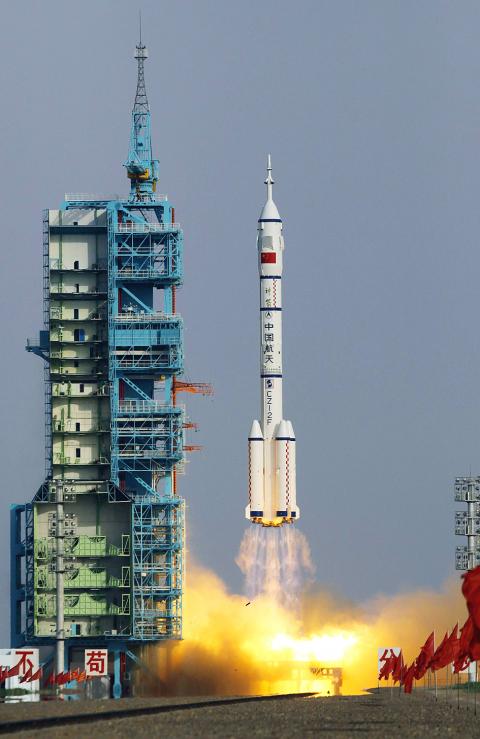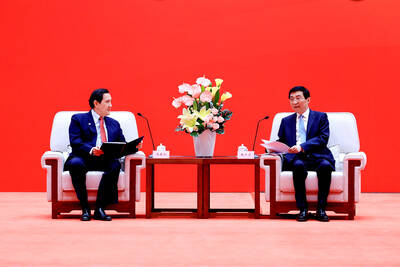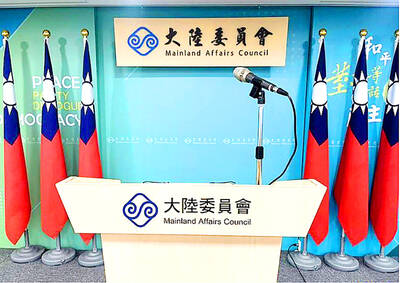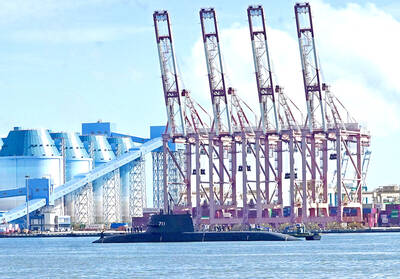China put its first woman into orbit yesterday, one of three astronauts to attempt a critical space docking in the latest challenge for the country’s ambitious space program.
A Long March rocket blasted off in the early evening from the remote Jiuquan Satellite Launch Center in the northwestern Gobi, carrying with it the Shenzhou 9 spacecraft and the three astronauts, including 33-year-old female fighter pilot Liu Yang (瀏陽)
This is China’s fourth manned space mission since 2003, when astronaut Yang Liwei (楊利偉) became the country’s first person in orbit, and comes as the US has curtailed manned launches over budget concerns and changing priorities.

Photo: Reuters
The launch was carried live on state television and until moments before blast-off, a camera showed the three astronauts in the cabin occasionally waving. A red placard with the Chinese symbol for good fortune hung behind them.
Within days, the astronauts will try to dock with the orbiting Tiangong (Heavenly Palace) 1 module launched in September last year, as part of a 13-day mission crucial to China’s ambition to put a space station in orbit about 2020.
“I believe that we can achieve this goal because we already have the basic technological capability,” Zhou Jianping (周建平), the chief designer of China’s manned space engineering project, told reporters before the launch.
A successful manned docking mission for China would be the -latest show of the country’s growing capabilities in space, to match its expanding military and diplomatic clout.
However, Beijing is playing catch-up with the US and Russia, which, along with other countries, jointly operate the International Space Station about 390km above Earth.
Rendezvous and docking techniques such as those which China is only testing now were mastered by the US and the former Soviet Union decades ago, and the 10.5m long Tiangong 1 is a trial module, not a full-fledged space station.
Linking with the unmanned module will be an important hurdle in China’s efforts to acquire the technological and logistical skills needed to run a full space lab that can house astronauts for long stretches.
Fears of a space arms race with the US and other powers mounted after China blew up one of its own weather satellites with a ground-based missile in January 2007, though China has insisted its program is peaceful.
“China’s manned space -program has never been for military purposes. It is mainly to research how mankind can go into space, use space peacefully,” He Yu (何宇), the general commander of China’s manned spacecraft project, said before the launch.
The US will not test a new rocket to take people into space until 2017 and Russia has said manned missions are no longer a priority.
However, NASA has begun investing in US firms to provide commercial spaceflight services and is spending about US$3 billion a year on a new rocket and capsule to send astronauts to the moon, asteroids and eventually to Mars.
Chinese scientists have talked of the possibility of sending a man to the moon after 2020, the final step in a three-stage moon plan, which includes the deployment of a moon rover in 2013 and the retrieval of lunar soil and stone samples in about 2017.
China’s space program has come a long way since late leader Mao Zedong (毛澤東), founder of Communist China in 1949, lamented that the country could not even launch a potato into space.

CHIP WAR: The new restrictions are expected to cut off China’s access to Taiwan’s technologies, materials and equipment essential to building AI semiconductors Taiwan has blacklisted Huawei Technologies Co (華為) and Semiconductor Manufacturing International Corp (SMIC, 中芯), dealing another major blow to the two companies spearheading China’s efforts to develop cutting-edge artificial intelligence (AI) chip technologies. The Ministry of Economic Affairs’ International Trade Administration has included Huawei, SMIC and several of their subsidiaries in an update of its so-called strategic high-tech commodities entity list, the latest version on its Web site showed on Saturday. It did not publicly announce the change. Other entities on the list include organizations such as the Taliban and al-Qaeda, as well as companies in China, Iran and elsewhere. Local companies need

CRITICISM: It is generally accepted that the Straits Forum is a CCP ‘united front’ platform, and anyone attending should maintain Taiwan’s dignity, the council said The Mainland Affairs Council (MAC) yesterday said it deeply regrets that former president Ma Ying-jeou (馬英九) echoed the Chinese Communist Party’s (CCP) “one China” principle and “united front” tactics by telling the Straits Forum that Taiwanese yearn for both sides of the Taiwan Strait to move toward “peace” and “integration.” The 17th annual Straits Forum yesterday opened in Xiamen, China, and while the Chinese Nationalist Party’s (KMT) local government heads were absent for the first time in 17 years, Ma attended the forum as “former KMT chairperson” and met with Chinese People’s Political Consultative Conference Chairman Wang Huning (王滬寧). Wang

CROSS-STRAIT: The MAC said it barred the Chinese officials from attending an event, because they failed to provide guarantees that Taiwan would be treated with respect The Mainland Affairs Council (MAC) on Friday night defended its decision to bar Chinese officials and tourism representatives from attending a tourism event in Taipei next month, citing the unsafe conditions for Taiwanese in China. The Taipei International Summer Travel Expo, organized by the Taiwan Tourism Exchange Association, is to run from July 18 to 21. China’s Taiwan Affairs Office spokeswoman Zhu Fenglian (朱鳳蓮) on Friday said that representatives from China’s travel industry were excluded from the expo. The Democratic Progressive Party government is obstructing cross-strait tourism exchange in a vain attempt to ignore the mainstream support for peaceful development

DEFENSE: The US would assist Taiwan in developing a new command and control system, and it would be based on the US-made Link-22, a senior official said The Ministry of National Defense is to propose a special budget to replace the military’s currently fielded command and control system, bolster defensive resilience and acquire more attack drones, a senior defense official said yesterday. The budget would be presented to the legislature in August, the source said on condition of anonymity. Taiwan’s decade-old Syun An (迅安, “Swift Security”) command and control system is a derivative of Lockheed Martin’s Link-16 developed under Washington’s auspices, they said. The Syun An system is difficult to operate, increasingly obsolete and has unresolved problems related to integrating disparate tactical data across the three branches of the military,